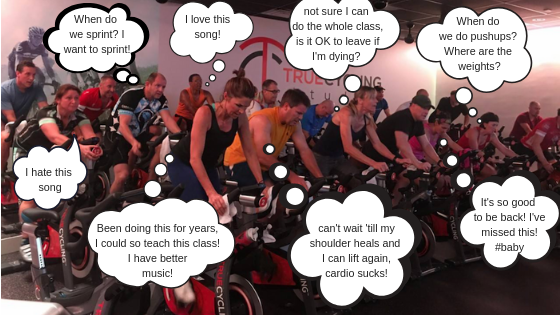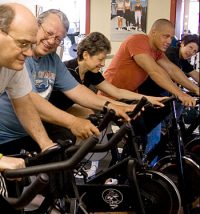The simplicity of indoor cycling means that classes are often filled with participants who have a wide range of fitness levels, skill levels, and experience. This presents challenges for instructors who strive to be attentive to each rider while being mindful of the entire class. Instructors may wonder if they can give equal attention to all riders, or if that is even necessary. Subbing a class or teaching a regular class with an influx of new riders (typical in the new year) is a balancing act.
Fortunately, these challenges come with opportunities for all instructors to up their game in coaching to varied abilities.
The factors that distinguish riders from each other fall into five categories:
Fitness Level
Some riders come in with outdoor cycling fitness and easily transition to indoor cycling. They understand the correlation between increasing intensity and improved fitness and manage well with little input from the instructor.
Other riders may be fit for their sport—for example, golf, skiing, or pickleball—but their endurance training lags. These riders have an athletic mindset and a base of fitness but still need coaching to master the proper use of the bike and cope with the demands of endurance training.
Regular gym members may have a baseline fitness level and are content to attend a class without aspiring to more rigorous athletic endeavors. They often claim that they’re “addicted” to exercise and they think they need little oversight due to years of attendance.
The “newbie” or first-timer is new to the gym, may be new to physical exertion, and has a low fitness level. They may struggle to endure the full length of the class for several weeks. While some may appreciate the extra attention they get in the beginning, others may shy away from it.

Skill Level
Even if someone rode a bike as a child, if they haven’t been cycling as an adult, they may not have the requisite skills to master smooth pedaling or standing up while pedaling. There isn’t an exact correlation between fitness and skill level when it comes to indoor cycling—not everyone understands the intricacies of how cadence and resistance work together and how to adjust their body position. It is common to see runners feel perplexed the first time they stand up if they haven’t added sufficient resistance to support their body weight.
Gauging how to pace oneself for a given duration takes time to figure out on a stationary bike if you’re new to it, no matter what your fitness level is. Even if the instructor has indicated that the hard intensity is to be sustained for 4 minutes, some riders will push themselves so hard that they fail after only 30–60 seconds, while others will breeze through the 4 minutes easily with energy to spare. Neither truly comprehended the instructions on how to achieve the desired intensity that would challenge them for 4 minutes. It is incumbent on the instructor to offer a variety of cues that speak to the diverse skills and experience in the class. She may be able to provide a suggested heart rate range to sustain for the experienced cyclist wearing a heart rate monitor, and more subjective cueing like RPE for those without heart rate monitors.
She may also add descriptions of how the riders might feel or draw parallels to what riders might relate to, and perhaps throw in some humor! For example: Imagine that at your normal pace, you’re actually 10 minutes from home but just remembered that you left the oven on. You must now get home in 4 minutes! Let’s do this!
Experience
Instructors who cultivate a sense of community in their classes reap the rewards of repeat riders. When the riders are familiar with the technical side of participating, such as bike setup, how to transition smoothly to a standing position, or how to sit back down without changing cadence or dropping power, the instructor can minimize cues.
Regardless of fitness or athletic ability, the experience of the riders will influence cueing and coaching from the instructor. Dual coaching might sound like this:
“For you regulars, welcome to the bottom of your 7-minute steep climb. The effort will be strong and steady with a recovery waiting for you at the top. Anticipate a 30-second sprint to crest this hill. For the rest of you, join me as we increase our resistance just a little bit every minute until we feel we can stand. This is your time to experience a hill that gets steeper as we climb. I promise you a rest at the top.”
Or…
“There are two more 2-minute hard intervals. I’ve watched each of you give your all for the past six intervals and I’m proud of you. I want to remind you that interval training can be personalized. Maybe you can’t imagine doing two, or even one more. That’s OK—try sitting one out and then reassess for the final one. Perhaps you know right now that you are completely cooked. That’s OK too; just ride easy. Or maybe you’re ready to make these last two even better than all the others you’ve done. Perfect. I’m here for you no matter what you choose.”
Physical attributes
A single class may have an older teen, an octogenarian, and every age in between. There may be special conditions that the riders exhibit or reveal to you before class, including pregnancy, injury, or chronic illness. Each of these will take specific coaching and cueing that targets a single rider and may call for discretion. Be acutely aware of these scenarios so you can determine when it’s best to approach the rider, mic turned off or covered, so you can deliver personalized instruction, motivation, or reassurance
Goals
The fifth factor that distinguishes your riders from each other is their personal goals. Everyone has different goals—their reasons for coming to your class. But this one is a bit different from the preceding four factors—this one is a result or a combination of the preceding four factors. Someone’s current level of fitness, plus their experience and skill level, combined with their physical attributes, will determine what they’d like to do with their commitment to an exercise program like an indoor cycling class. Their goal may have to do with changing something about themselves, or the desire to register for their first competition (half-century, fun-run, triathlon, etc.), or setting a personal best of some kind, or it may include other factors such as the desire to be healthy so they can play with their grandkids or look good at an upcoming wedding. You can see how those four previous factors also affect one’s goals.
Always keep in mind that everyone in your class may have different goals, which can affect how you coach them. Take some time to get to know your riders on a deeper level to understand their personal reasons for coming to class. To aid in uncovering their goals, consider using one of our signature rides at ICA called “How Big Is Your Why.” While we typically repost this for New Year’s, the inspirational coaching in this profile is ideal for uncovering the deepest reasons why your riders want to make positive changes in their lives, any time of the year.
Make sure to read Part 2 of this series; you will learn seven actionable tips on how to teach to a mixed class.


Thank you, Cori. I am a newbie here, and I am very happy to have found this site. I recognized some of my challanges in your article. One of the most difficulties in my practice is to convince those who have no experience to allow themselves time, before they do as the experienced ones…
Beata, I have a saying…Never compare your beginning to someone else’s middle. It is a challenge because we all want maximum gains in the shortest amount of time as possible, but recognizing that time spent leads to the most sustainable growth is also the most rewarding. Welcome to teaching!!
That’s great, Lyn…let us know how it’s going! I do love a homogenous group with a singular focus, but for the most part, the groups in front of us are very varied and that creates an awesome dynamic and keeps it interesting!
LOve this article. And yes I teach at country clubs where there are 20 year olds all the way to 85. It is a challenge but its been working out great. I definitely take everything you wrote into consideration. Looking forward to part 2.